ASX reporting season update - Good enough for the optimists

Foresight Analytics
Key Points
- Investors need to keep in mind that reporting season in Australia is occurring at a significant turning point in the global economic cycle. Cost pressures have been well understood and there were not too many misses solely on underestimated costs. However, the outlook for earnings has considerable downside risk in our view. Some management teams addressed this by withholding guidance, but others tried to comfort investors by trumpeting how resilient their businesses will be to further costs and higher rates.
- Communication services, Real estate, Consumer staples, Industrials and Energy provided the upside surprise in FY22. Utilities, Materials and Consumer Discretionary saw their fair share of misses. Retail saw a positive earnings surprise and JBH said the start to FY23 had been positive. In our view, the high household savings rate means the consumer will likely be relatively resilient to the start of the tightening cycle by the RBA, but ultimately this will wane as interest rates rise.
- The CBA result highlighted the strength of the economy prior to the interest rate rises. However, management indicated housing and business lending growth will likely slow. The impact of slower lending growth on earnings will be offset by an increasing net interest margin as interest rates rise. REA’s management team thinks it will be resilient to the property downturn because agents finding it more difficult to sell properties will be drawn to their platform. This may the situation now, but ultimately higher interest rates will lower transaction volumes.
- Global cyclicals with market power such as BXB and AMC have shown that costs can be passed on. Clever structuring of contract terms and a strong market position have allowed WOR to pass on costs and hire new staff in a globally tight jobs market. The business is benefitting from higher oil prices in the short-term, but also the longer-term shift to renewables.
- Japan and Australia have been our preferred equity markets for the past year as the US yield curve has flattened and inverted. Key US business surveys are also signaling a US recession is brewing. We will update our TAA/DAA outlook next week and plan to move further underweight in risk assets.
A reporting season that keeps the optimists in
Investors need to keep in mind that reporting season in Australia is occurring at a significant turning point in the global economic cycle.
Central banks have been raising interest rates, but the full effect of the tightening in financial conditions has not fully impacted either reported earnings, nor the earnings outlook. At the Jackson Hole central bank conference last weekend, Fed chairman, Jerome Powell, promised there would be even more tightening required to bring inflation back to target and the RBA has signaled further interest rate rises are likely.
Analysts seem to have understood the impact of cost pressures on earnings in H2 FY22. The Chinese property market slowdown is already weighing on the commodity producers, but management team with businesses exposed remain relatively positive.
We will soon release our latest asset allocation update and flag with our readers that we are likely to move further underweight risk assets. We advised that a rally in risk assets was likely after the 20% correction in first 6 months of the year; not because the earnings outlook was about to improve, but because sentiment had become extremely negative. The tactical rally has lost momentum in the past few weeks and after Jackson Hole is no surprise. The earnings season both in Australia and US were good enough to attract overly bearish investors back into the market. However, this doesn’t change our fundamental positioning – the global economy is heading for recession and we need to soon move underweight risk assets.
At this stage, 72% of ASX 200 stocks have reported and 61% have beaten analysts’ EPS estimates (Figure 1). Communication services, Real estate, Consumer staples, Industrials and Energy all punched above their weight.
Revenue growth was generally better than expected, with Energy, Industrials, Consumer staples, IT, Communication services, and Materials seeing stronger than average revenu
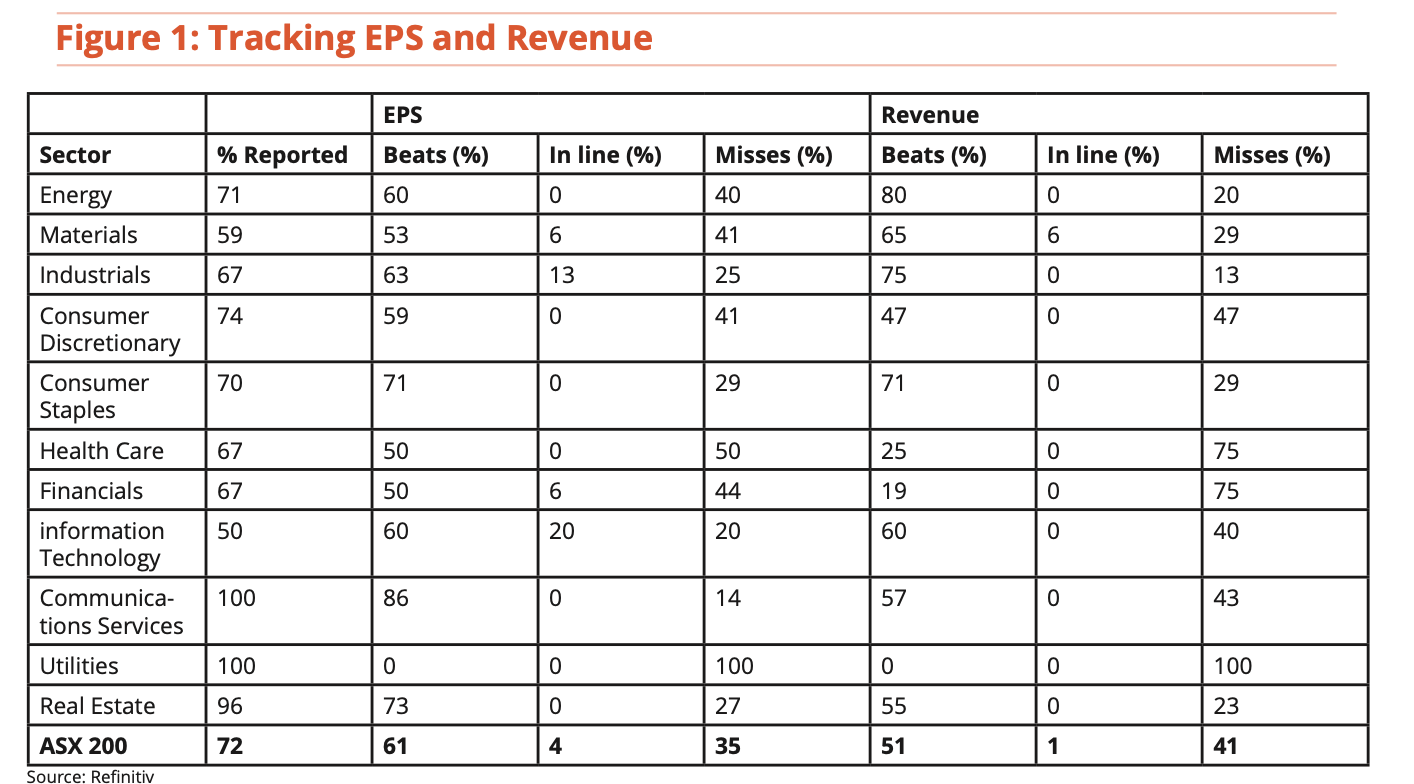
Global growth concerns have weighed upon Energy and Materials in recent weeks, while concerns about the domestic consumer have weighed upon Consumer durables and Retail.
The RBA has said that it expects the consumer to be able to withstand its tightening plans due in part to a high level of savings generated during the pandemic. We think the RBA’s optimism rests not so much on the level of savings, but the high savings rate before the start of its tightening cycle. The RBA interest rate rises will reduce the savings rate, but it won’t impact overall spending or the discretionary: non-discretionary spending mix. Once an equilibrium level of savings is reached or a savings rate the household sector wants to maintain then the interest rate rises will impact spending. Prior to the pandemic this savings rate was around 5%.
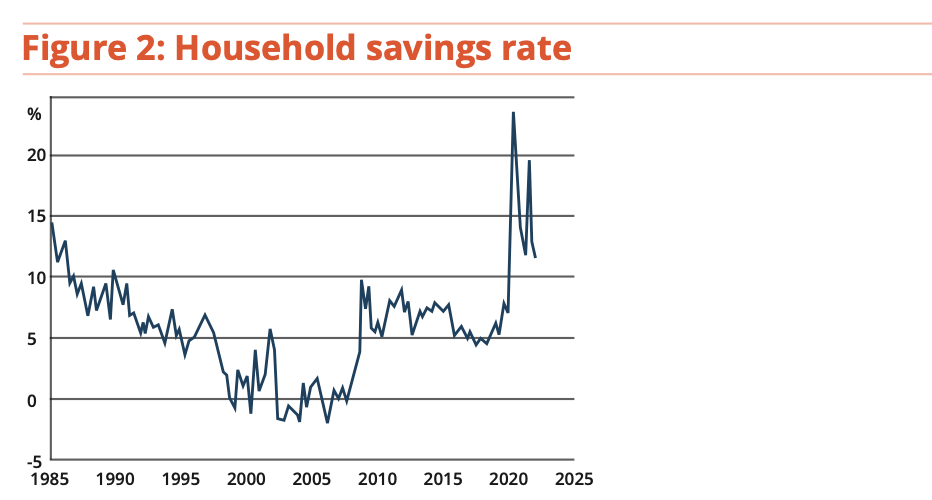
Despite Utilities missing on both EPS and revenue, the sector posted a strong 3.1% gain in August (Figure 3). Defensive industries such as Food and drugs, Pharmaceuticals, Real estate, and Healthcare equipment have all outperformed during reporting season. However, Banks, Software, and Diversified financials have outperformed.
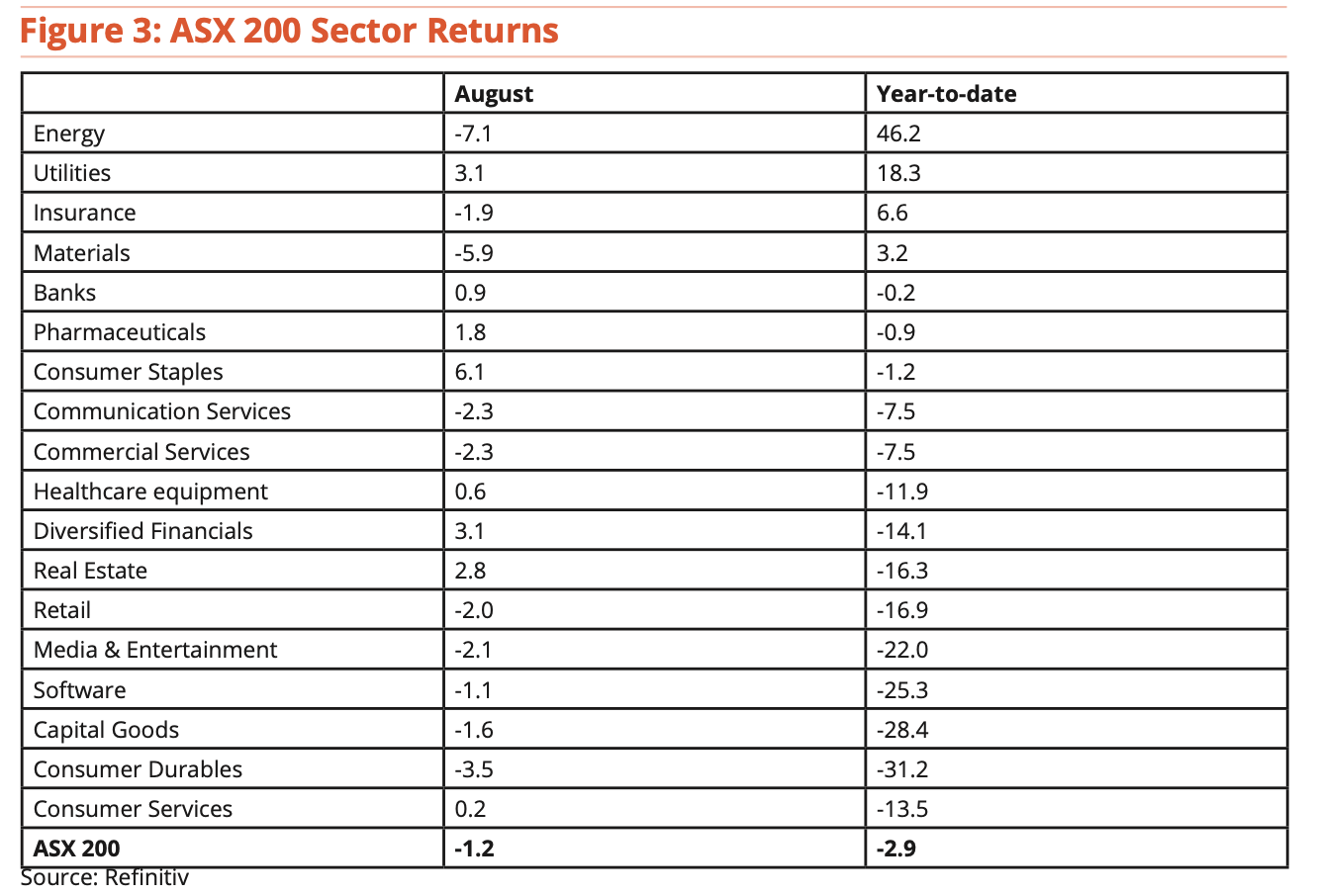
Industry level FY22 earnings expectations just prior to the start of reporting season are summarised in Figure 4. The surprise on preferred earnings for the ASX200 was tracking at 3.1%, led by Transport, Insurance, and Consumer services and is broadly in line with expectations at the start of reporting season. The misses were largest in Utilities and Diversified Financials, although these industry groups performance well during the month.
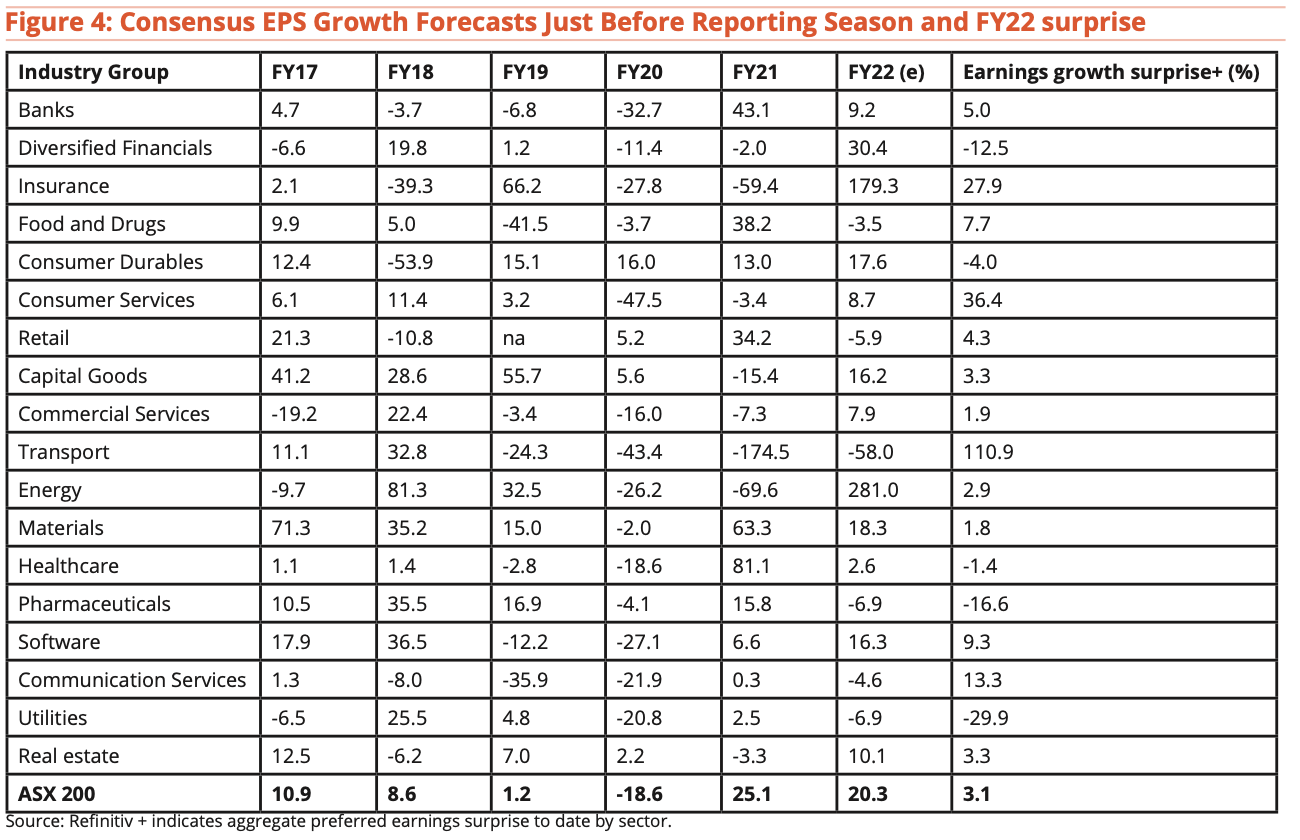
Revenue growth in the ASX200 universe was expected to be 10.6% and the results thus far seem to be in line with analysts’ expectations. The surprise in Transport was large and probably reflects the industry’s ability to pass on upstream cost pressures.
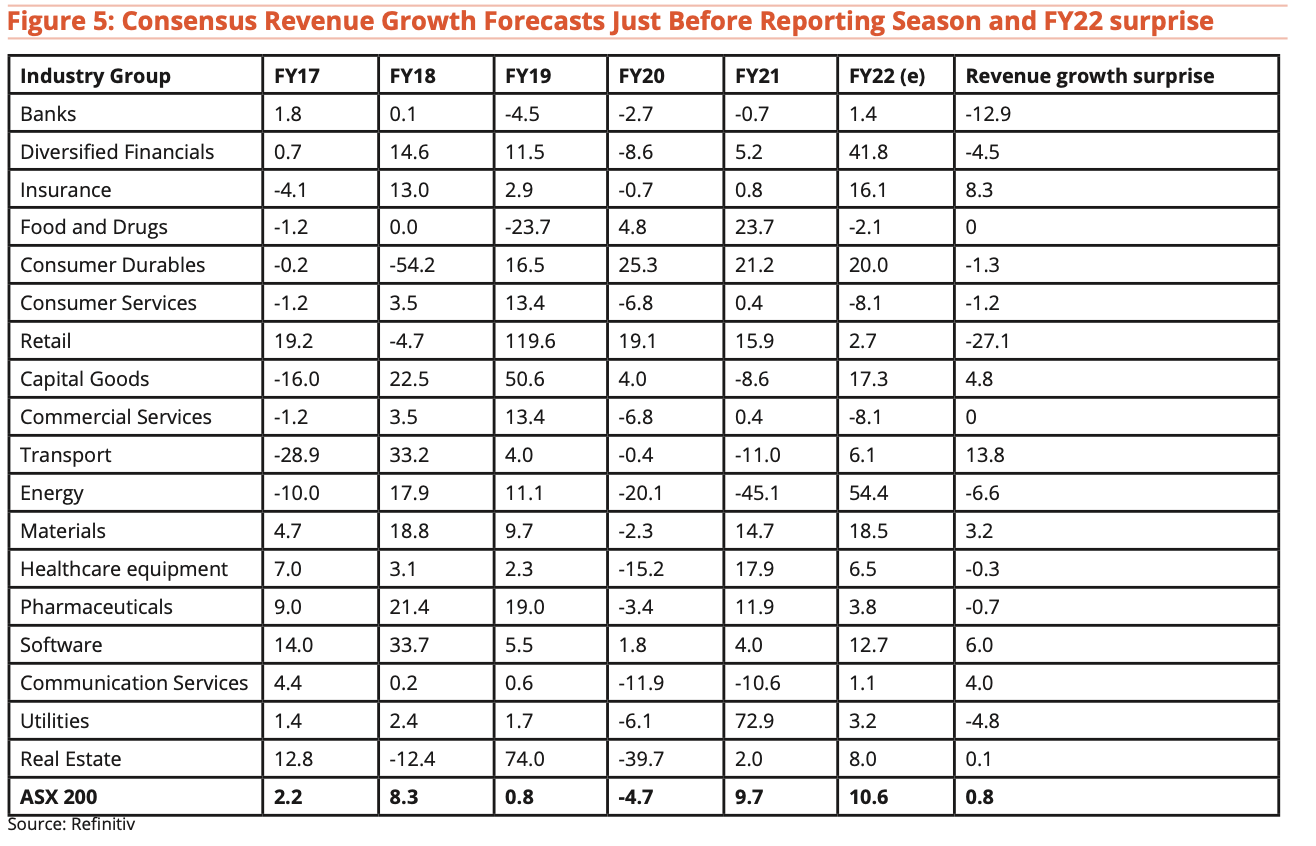
Reporting season highlights
Macro factors such as the impact of the Ukraine War on commodity prices and cost pressures were front and centre this reporting season. The domestic interest rate rises that began in May did not have an impact on earnings, but some stocks such as FLT, ORG and JBH resisted calls by analysts to provide guidance for FY23. This highlights the uncertainty about the year ahead and shows how vulnerable the market is in our view.
Global cyclicals such as BXB and AMC reported strong cost pressures, but their market power has seen them pass on these costs to customers. WOR also saw cost pressures as well but the structure of its contracts with clients allowed them to pass these costs on. The business appears to be one of the few who are benefitting from the short-term rise in energy prices and the longer-term transition to renewables. Management mentioned in detail the optimistic outlook from the Biden administration’s $US300bn Inflation Reduction Act.
Stocks such as BLD and ABC have more limited ability to pass on higher fuel costs. The La Nina weather pattern that has been affecting the east coast of Australia also had a large impact on earnings, with many delays in both residential, commercial and infrastructure building projects.
CBA saw a decline in its net interest margin (NIM), but said in the year ahead the NIM would rise as monetary policy normalises. Management also warned that impairment charges and arrears are likely to increase as well. A broad slowdown in credit growth will also slow earnings growth in FY23.
Management teams in businesses such as JBH, REA, BSL, CAR, FLT seem to think they are recession-proof. However, amongst all of the uncertainty about the global economic outlook, stocks such as CSL see an enduring recovery from the pandemic and a large acquisition as a key driver of their earnings outlook – this seems to be underappreciated by the market.
Vertically integrated energy producers such as ORG are seeing large margin expansion their production business offset by margin compression in the retail business as production costs cannot be passes through quick enough and this creates uncertainty about the group earnings outlook in the year ahead. One-off’s such as ORG’s equity sale to ConocoPhillips also detracted from earnings, but this was flagged much earlier to the market.
The fortunes of the diversified miners were driven by macro factors including the slowdown in the Chinese economy and property market and the Ukraine War. The Chinese slowdown due to COVID lockdowns and the weakness in the property market led to lower volumes in iron ore and this negatively affected RIOs result. While BHP benefitted from the impact of the Ukraine War on energy markets. More recently energy markets have been concerned about slower global economic growth.
BHP management passed on the windfall from higher energy prices to shareholders by raising the dividend, while RIO returned its payout to target levels. RIO management said it wasn’t concerned about the global outlook and didn’t use this as a reason to cut the dividend.
Reporting Season Summary: Selected stocks
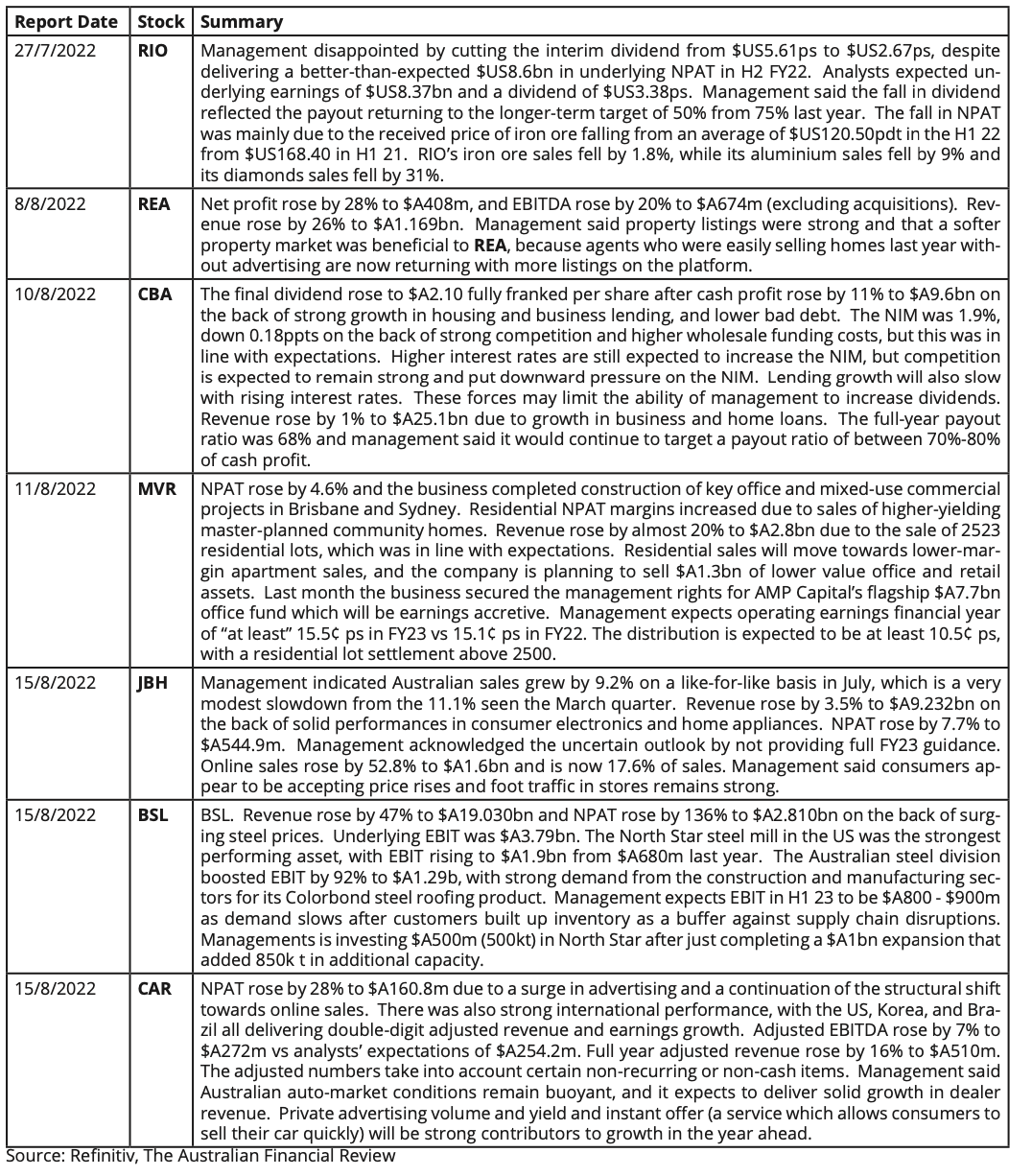
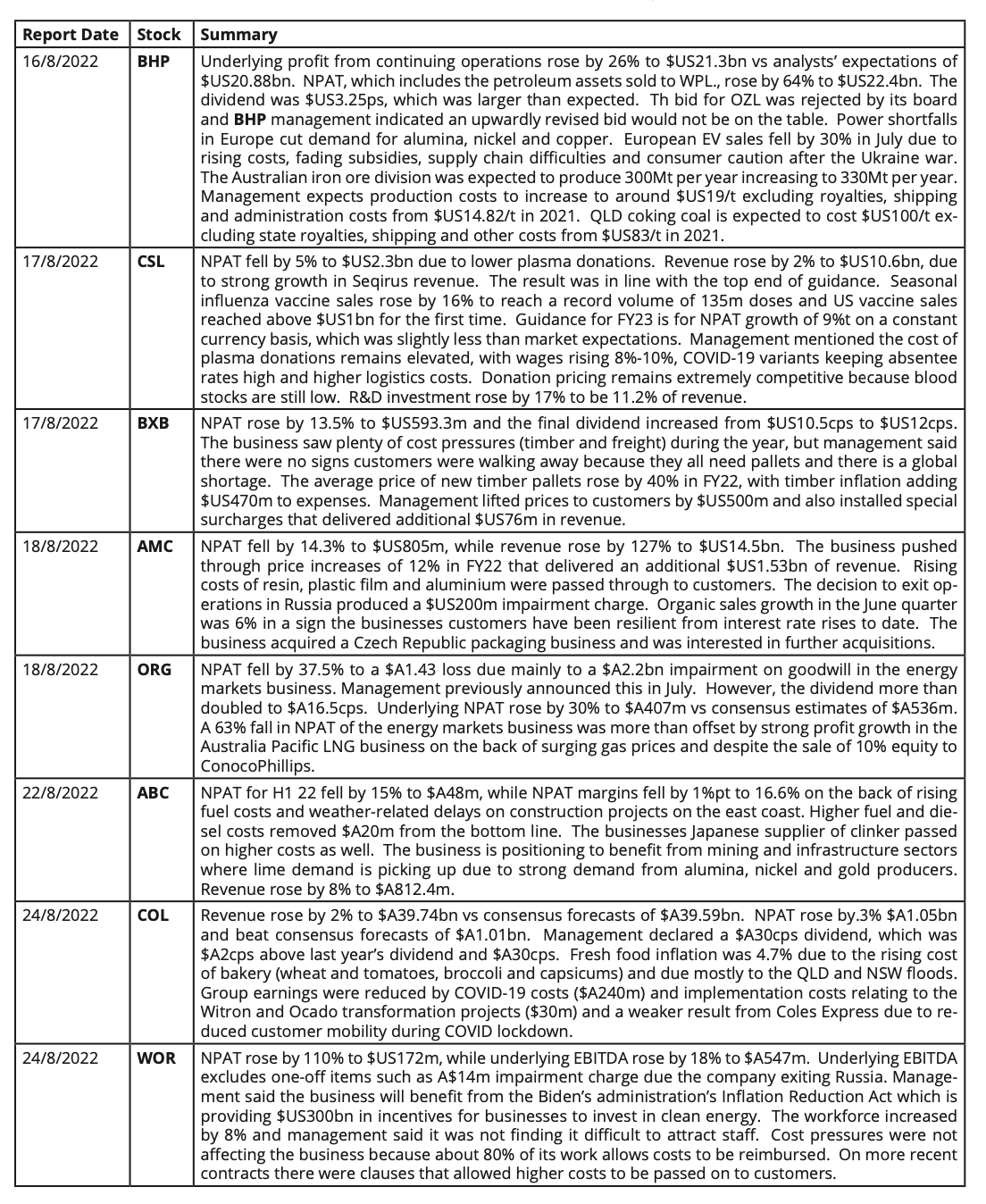
About Foresight Analytics
Foresight is a data-driven, investment research, analytics, and consulting firm. Foresight is not owned by any product provider or manufacturer. The firm’s business model is purely based on fee-for-service. Using its innovative, evidence-based framework, Foresight provides analytical, predictive and market intelligence solutions to leading investment management companies, superannuation funds and wealth groups. Foresight’s capabilities are underpinned by leading data and technology infrastructure that blends statistical, fundamental, and behavioural insights.
Foresight’s fiduciary solutions includes Diligence Services and Ratings (Investment, ESG, Risk and Operational Diligence), Advanced Portfolio Analytics and Strategic Research.
Foresight’s fund strategy solutions include Advanced Analytics for asset managers, Fund strategy positioning and benchmarking services, fund industry intelligence and research as well as Strategic process review, integration, and validation services.
2 topics

Shane Lee is a strategist at Foresight Analytics. He has as around 20 years’ experience in various sell-side research and asset allocation roles. He was the asset allocation analyst at ANZ wealth/IOOF for a 2-year period between 2017 and 2019....
Expertise

Shane Lee is a strategist at Foresight Analytics. He has as around 20 years’ experience in various sell-side research and asset allocation roles. He was the asset allocation analyst at ANZ wealth/IOOF for a 2-year period between 2017 and 2019....
